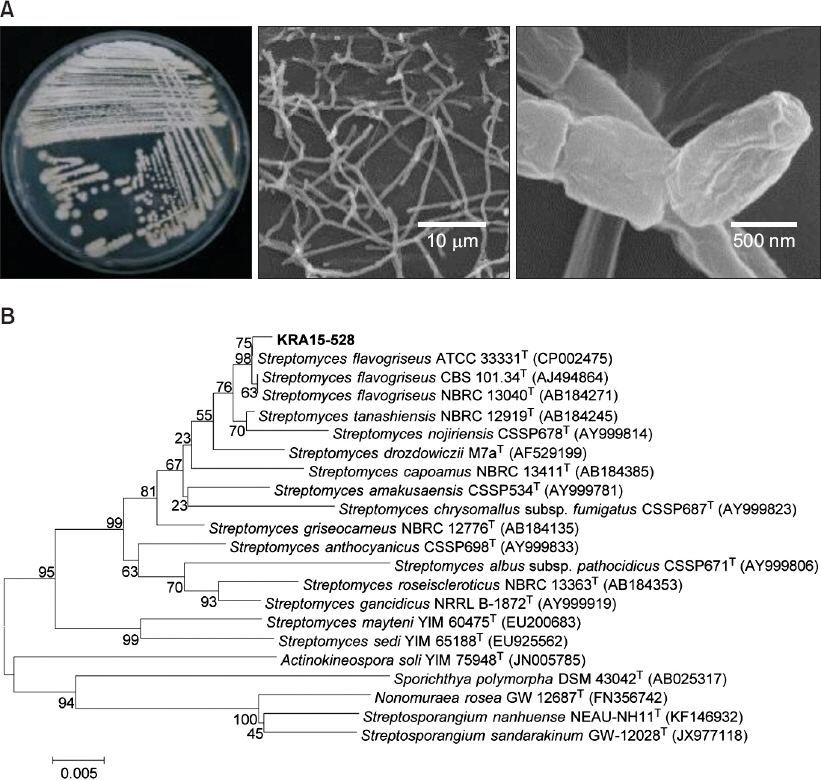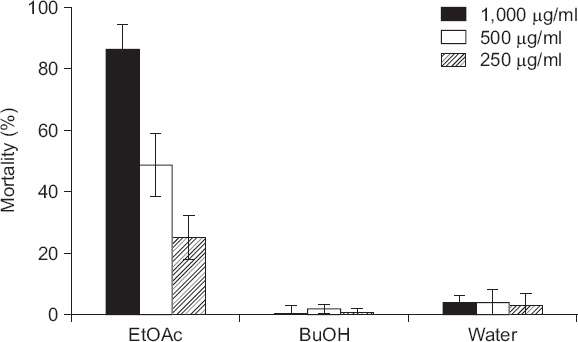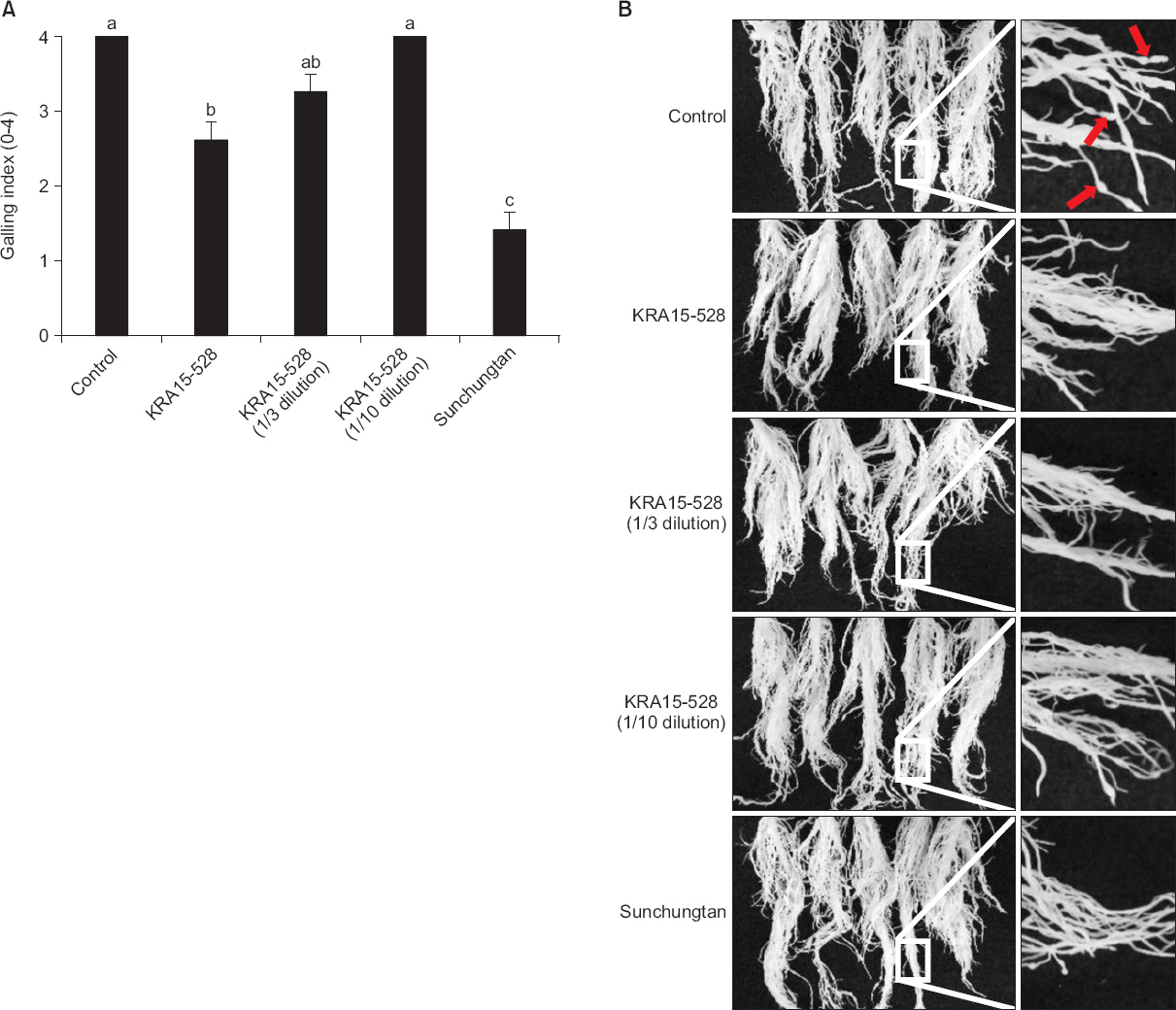Abbott, W.S 1925. A method of computing the effectiveness of an insecticide.
J Econ Entomol 18: 265-267.

Akhtar, M and Malik, A 2000. Roles of organic soil amendments and soil organisms in the biological control of plant-parasitic nematodes: a review.
Bioresour. Technol 74: 35-47.

Barker, K.R, Schmitt, D.P and Imbriani, J.L 1985. Nematode population dynamics with emphasis on determining damage potential to crops. In: An Advanced Treatise on Meloidogyne Volume II: Methodology, eds. by K. R Barker, C.C Carter and J. N Sasser, pp. 135-148. North Carolina State University, Raleigh, NC, USA.
Bérdy, J 2005. Bioactive microbial metabolites.
J. Antibiot 58: 1-26.


Burg, R.W, Miller, B.M, Baker, E.E, Birnbaum, J, Currie, S.A, Hartman, R, Kong, Y.L, Monaghan, R.L, Olson, G, Putter, I, Tunac, J.B, Wallick, H, Stapley, E.O, Oiwa, R and Omura, S 1979. Avermectins, new family of potent anthelmintic agents: producing organism and fermentation.
Antimicrob. Agents Chemother 15: 361-367.




Caillaud, M.C, Dubreuil, G, Quentin, M, Perfus-Barbeoch, L, Lecomte, P, de Almeida Engler, J, Abad, P, Rosso, M.N and Favery, B 2008. Root-knot nematodes manipulate plant cell functions during a compatible interaction.
J. Plant Physiol 165: 104-113.


Dezfully, N.K and Ramanayaka, J.G 2015. Isolation, identification and evaluation of antimicrobial activity of
Streptomyces flavogriseus strain ACTK2 from soil sample of Kodagu, Karnataka State (India).
Jundishapur J. Microbiol 8: e15107.


Ghorbel, S, Kammoun, M, Soltana, H, Nasri, M and Hmidet, N 2014.
Streptomyces flavogriseus HS1: isolation and characterization of extracellular proteases and their compatibility with laundry detergents.
BioMed Res. Int 2014. 345980




Hesseltine, C.W, Benedict, R.G and Pridham, T.G 1954. Useful criteria for species differentiation in the genus
Streptomyces.
Ann. N. Y. Acad. Sci 60: 136-151.


Hwang, S.M, Park, M.S, Kim, J.C, Jang, K.S, Choi, Y.H and Choi, G.J 2014. Occurrence of
Meloidogyne incognita infecting resistant cultivars and development of an efficient screening method for resistant tomato to the
Mi-virulent nematode.
Korean J. Hortic. Sci. Technol 32: 217-226. In Korean

Jang, J.Y, Choi, Y.H, Joo, Y.J, Kim, H, Choi, G.J, Jang, K.S, Kim, C.J, Cha, B, Park, H.W and Kim, J.C 2015. Characterization of
Streptomyces netropsis showing a nematicidal activity against
Meloidogyne incognita.
Res. Plant Dis 21: 50-57. In Korean

Jang, J.Y, Choi, Y.H, Shin, T.S, Kim, T.H, Shin, K.S, Park, H.W, Kim, Y.H, Kim, H, Choi, G.J, Jang, K.S, Cha, B, Kim, I.S, Myung, E.J and Kim, J.C 2016. Biological control of
Meloidogyne incognita by
Aspergillus niger F22 producing oxalic acid.
PLoS One 11: e0156230



Kerry, B.R 2000. Rhizosphere interactions and the exploitation of microbial agents for the biological control of plant-parasitic nematodes.
Annu. Rev. Phytopathol 38: 423-441.


Kim, K.H, Joe, Y.A, Choi, S.R and Goo, Y.M 1989. Comparative studies on streptomycin producing strains and media. Korean J. Biotechnol. Bioeng 4: 162-166.
Kim, S.J, Yu, Y.M and Whang, K.S 2014. Molecular identification of
Meloidogyne spp. in soils from fruit and vegetable greenhouses in Korea.
Korean J. Appl. Entomol 53: 85-91.

Kim, S.S, Kang, S.I, Kim, J.S, Lee, Y.S, Hong, S.H, Naing, K.W and Kim, K.Y 2011. Biological control of root-knot nematode by
Streptomyces sampsonii KK1024.
Korean J. Soil Sci. Fertil 44: 1150-1157.

Lacey, E, Gill, J.H, Power, M.L, Rickards, R.W, O’Shea, M.G and Rothschild, J.M 1995. Bafilolides, potent inhibitors of the motility and development of the free-living stages of parasitic nematodes.
Int. J. Parasitol 25: 349-357.


Larkin, M.A, Blackshields, G, Brown, N.P, Chenna, R, McGettigan, P.A, McWilliam, H, Valetin, F, Wallace, I.M, Wilm, A, Lopez, R, Thompson, J.D, Gibson, T.J and Higgins, D.G 2007. Clustal W and Clustal X version 2.0.
Bioinformatics 23: 2947-2948.


Lasota, J.A and Dybas, R.A 1991. Avermectins, a novel class of compounds: implications for use in arthropod pest control.
Annu. Rev. Entomol 36: 91-117.


McCart, J.P 2009. Molecular approaches toward resistance to plant-parasitic nematdoes. In: Cell Biology of Plant Nematode Parasitism, eds. by R. H Berg and C. G Tayor, pp. 239-267. Springer, St. Louis, MO, USA.
Nonaka, K, Tsukiyama, T, Okamoto, Y, Sato, K, Kumasaka, C, Yammoto, T, Maruyama, F and Yoshikawa, H 2000. New milbemycins from
Streptomyces hygroscopicus subsp.
aureolacrimosus: fermantation, isolation and strucutre elucidation.
J. Antibiot 53: 694-704.

Oka, Y, Koltai, H, Bar-Eyal, M, Mor, M, Sharon, E, Chet, I and Spiegel, Y 2000. New strategies for the control of plant-parasitic nematodes.
Pest Manag. Sci 56: 983-988.

Park, M.H, Kim, J.K, Choi, W.H and Yoon, M.H 2011. Nematicidal effect of root-knot nematode (
Meloidogyne incognita) by biological nematicide.
Korean J. Soil Sci. Fertil 44: 228-235.

Park, M.H, Walpola, B.C, Kim, S.J and Yoon, M.H 2012. Control effect of root-knot nematode (
Meloidogyne incognita) by biological nematicide.
Korean J. Soil Sci. Fertil 45: 162-168.

Perry, R.N and Moens, M 2006. Plant Nematology. 2nd ed CABI, Boston, MA, USA. pp. 74
Putter, I, Mac Connell, J.G, Preiser, F.A, Haidri, A.A, Ristich, S.S and Dybas, R.A 1981. Avermectins: novel insecticides, acaricides and nematicides from a soil microorganism.
Experientia 37: 963-964.


Roberts, T.R and Hutson, D.H 1999. Metabolic Pathways of Agrochemicals, Part 2: Insecticides and Fungicides. Royal Society of Chemistry. Cambridge, UK. pp. 741-743.
Rodriguez-Kabana, R, Morgan-Jones, G and Chet, I 1987. Biological control of nematodes: soil amendments and microbial antagonists.
Plant Soil 100: 237-247.


Ruanpanun, P, Laatsch, H, Tangchitsomkid, N and Lumyong, S 2011. Nematicidal activity of fervenulin isolated from a nematicidal actinomycete
Streptomyces sp. CMU-MH021, on
Meloidogyne incognita.
World J. Microbiol. Biotechnol 27: 1373-1380.



Sahebani, N and Hadavi, N 2008. Biological control of the root-knot nematode
Meloidogyne javanica by
Trichoderma harzianum.
Soil Biol. Biochem 40: 2016-2020.

Saitou, N and Nei, M 1987. The neighbor-joining method: a new method for reconstructing phylogenetic trees.
Mol. Biol. Evol 4: 406-425.

Sharon, E, Bar-Eyal, M, Chet, I, Herrera-Estrella, A, Kleifeld, O and Spiegel, Y 2001. Biological control of the root-knot nematode
Meloidogyne javanica by
Trichoderma harzianum.
Phytopathology 91: 687-693.


Siddiqui, I.A and Shaukat, S.S 2003. Suppression of root-knot disease by
Pseudomonas fluorescens CHA0 in tomato: importance of bacterial secondary metabolite, 2, 4-diacetylpholoroglucinol.
Soil Biol. Biochem 35: 1615-1623.

Siddiqui, Z.A and Mahmood, I 1999. Role of bacteria in the management of plant parasitic nematodes: a review.
Bioresour. Technol 69: 167-179.

Southey, J.F 1986. Laboratory Methods for Work with Plant and Soil Nematodes. Ministry of Agriculture Fisheries and Food, Her Majesty’s Stationary Office, London, UK. pp. 202
Tamura, K, Stecher, G, Peterson, D, Filipski, A and Kumar, S 2013. MEGA6: molecular evolutionary genetics analysis version 6.0.
Mol. Biol. Evol 30: 2725-2729.



Taylor, A.L and Sasser, J.N 1978. Biology, Identification and Control of Root-Knot Nematodes (Meloidogyne species). Department Plant Pathology North Carolina State University and United States Agency for International Development, Raleigh, NC, USA. pp. 111 pp.
Tripathi, G and Rawal, S.K 1998. Simple and efficient protocol for isolation of high molecular weight DNA from Streptomyces aureofaciens. Biotechnol. Tech 12: 629-631.
Trudgill, D.L and Blok, V.C 2001. Apomictic, polyphagous root-knot nematodes: exceptionally successful and damaging biotrophic root pathogens.
Annu. Rev. Phytopathol 39: 53-77.


Watve, M.G, Tickoo, R, Jog, M.M and Bhole, B.D 2001. How many antibiotics are produced by the genus
Streptomyces?
Arch. Microbiol 176: 386-390.



Williams, S.T and Davies, F.L 1967. Use of a scanning electron microscope for the examination of actinomycetes.
J. Gen. Microbiol 48: 171-177.


Williamson, V.M and Hussey, R.S 1996. Nematode pathogenesis and resistance in plants.
Plant Cell 8: 1735-1745.



Zeng, Q, Huang, H, Zhu, J, Fang, Z, Sun, Q and Bao, S 2013. A new nematicidal compound produced by
Streptomyces albogriseolus HA10002.
Antonie Van Leeuwenhoek 103: 1107-1111.




Zhao, Z.H, Li, J.Y, Yang, X.Y and Chu, Y.W 2003. SIIA-C2191-A and B, novel polycyclic xanthone antibiotics produced by Streptomyces flavogriseus I. Taxonomy, fermentation, isolation and biological activities. Chin. J. Antibiot 28: 627-632.







 PDF Links
PDF Links PubReader
PubReader Full text via DOI
Full text via DOI Download Citation
Download Citation Print
Print






